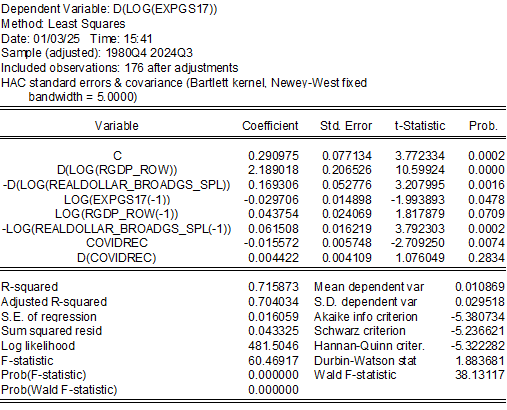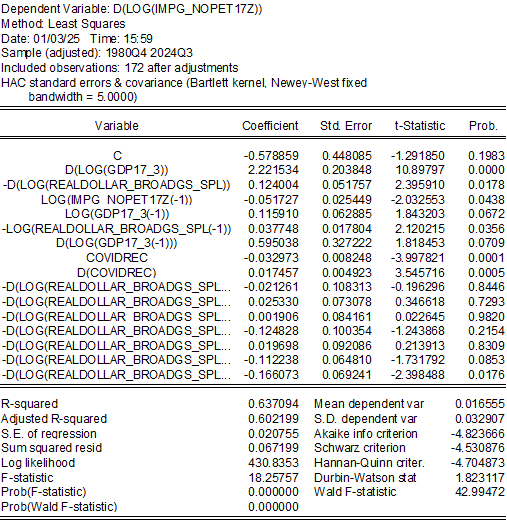JW Mason asserts that, in focusing on the real exchange rate, I’m on the side of relative prices being the primary determinant of flows.
Here is one of the big cleavages between orthodox and (Post) Keynesian approaches to international economics: are trade flows mainly driven by relative prices, or by demand?
On the contrary, I think incomes are very important. This is demonstrated by my work on trade flows explained here. Updating, to 2024, I estimate for 1980-2024:
Δ exp t = β 0 + φ exp t-1 + β 1 y *t-1 + β 2 q t-1 + γ 1 Δ y *t + γ 2 Δq t + u t
Δ imp t = β 0 + φ imp t-1 + β 1 y t-1 + β 2 q t-1 + γ 1 Δy t + γ 2 Δq t + seven lags of Δq t + u t
Each error correction model specification includes a covid dummy (2020Q1-Q2) and first difference thereof.
For US exports of goods and services:
This implies the long run elasticity of exports with respect to the dollar exchange rate is 2.07, while that of income (rest-of-world trade-weighted GDP) is 1.47.
This compares with a 2.3 and 1.9 as found in Chinn (2004).
For goods imports, the real exchange rate is important as well, although it’s more difficult to obtain a statistically significant estimates.
The long lags in the exchange rate are consistent with numerous studies indicating that the effects of the exchange rate take a long time to have an effect (it’s consistent with the graph in this post).
The long run elasticity of goods imports (ex-oil) with respect to the dollar is 0.74, and with respect to US income is 2.24.
In Chinn (2004), I obtain long run estimates of -0.2 and 2.3 for total imports, respectively. In Chinn (2010), I obtain estimates of -0.5 and 2.2 respectively, for ex-petroleum goods imports, for data up to 2010.
Hence, income is important, as are relative prices. I think of this as a conventional view (see e.g., Rose and Yellen, JME 1989), rather than orthodox vs. post-Keynesian view.
Now, as for relative importance, one can look at standardized (or “beta”) coefficients, which are OLS coefficients divided and multiplied standard deviations. For an exports regression estimated in first differences, the income “beta” coefficient is about four times the size of that for the exchange rate. For the non-oil goods import first differences equation, the income “beta” coefficient is about ten times that of the exchange rate coefficient.



